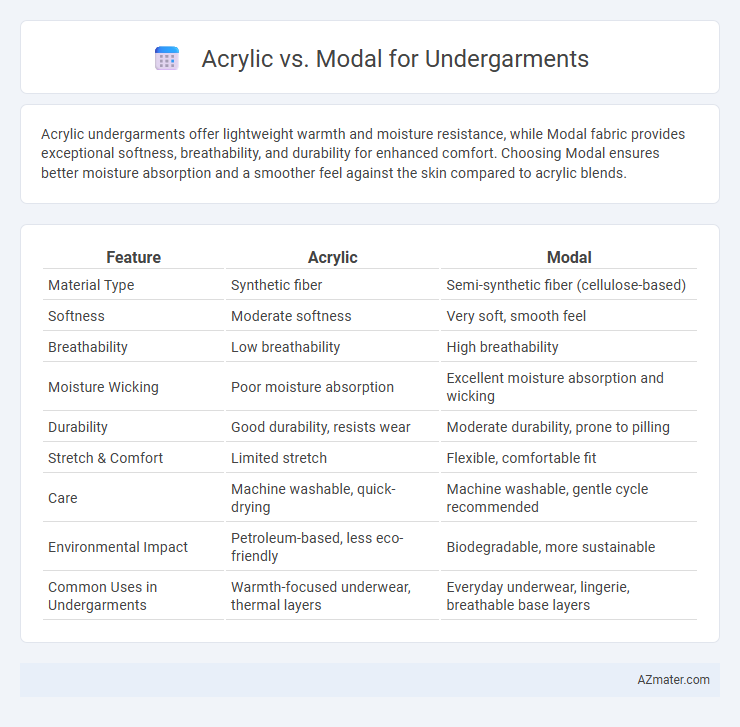Acrylic undergarments offer lightweight warmth and moisture resistance, while Modal fabric provides exceptional softness, breathability, and durability for enhanced comfort. Choosing Modal ensures better moisture absorption and a smoother feel against the skin compared to acrylic blends.
Table of Comparison
| Feature | Acrylic | Modal |
|---|---|---|
| Material Type | Synthetic fiber | Semi-synthetic fiber (cellulose-based) |
| Softness | Moderate softness | Very soft, smooth feel |
| Breathability | Low breathability | High breathability |
| Moisture Wicking | Poor moisture absorption | Excellent moisture absorption and wicking |
| Durability | Good durability, resists wear | Moderate durability, prone to pilling |
| Stretch & Comfort | Limited stretch | Flexible, comfortable fit |
| Care | Machine washable, quick-drying | Machine washable, gentle cycle recommended |
| Environmental Impact | Petroleum-based, less eco-friendly | Biodegradable, more sustainable |
| Common Uses in Undergarments | Warmth-focused underwear, thermal layers | Everyday underwear, lingerie, breathable base layers |
Introduction to Acrylic and Modal Fabrics
Acrylic fabric, a synthetic fiber made from polymer compounds, is known for its lightweight, soft texture and excellent moisture-wicking properties, making it a common choice for durable undergarments. Modal, a semi-synthetic fiber derived from beech tree pulp, offers superior breathability, high absorbency, and a silky finish, which enhances comfort in intimate wear. Both fabrics provide different benefits in terms of moisture management and softness, influencing their suitability for undergarments based on user preference and activity level.
Origin and Production Processes
Acrylic fibers, derived from polymer synthesis through the polymerization of acrylonitrile, originate from petrochemical sources and undergo processes like spinning and drawing to achieve soft, wool-like properties. Modal, a type of rayon, is produced by chemically treating beech tree cellulose with sodium hydroxide and carbon disulfide, then regenerated into fibers through wet spinning, emphasizing sustainable wood pulp origins. The differing raw materials--synthetic polymers for acrylic and natural cellulose for modal--define distinct environmental footprints and performance characteristics in undergarment manufacturing.
Comfort and Softness Comparison
Modal fabric offers superior softness and breathability compared to acrylic, making it ideal for comfortable undergarments. Acrylic fibers tend to be less breathable and can feel rougher against the skin, potentially causing irritation during extended wear. Modal's moisture-wicking properties and smooth texture provide enhanced comfort, especially in sensitive areas.
Moisture-Wicking and Breathability
Modal fabric outperforms acrylic in moisture-wicking capabilities due to its natural cellulose fibers that absorb and release moisture efficiently, keeping undergarments dry and comfortable. Acrylic tends to trap heat and moisture, resulting in reduced breathability and potential discomfort during extended wear. Modal's superior breathability makes it an ideal choice for undergarments, promoting better air circulation and enhanced overall comfort.
Durability and Longevity
Acrylic fibers in undergarments offer high durability due to their resistance to wear, fading, and moisture, making them suitable for long-term use. Modal fabric, derived from beech tree pulp, boasts excellent longevity with superior softness and breathability but can be less resilient to repeated washing and abrasion compared to acrylic. Choosing between acrylic and modal depends on prioritizing either durable, colorfast performance or enhanced comfort with moderate durability in undergarments.
Hypoallergenic and Skin Sensitivity Factors
Modal fabric is highly recommended for undergarments due to its natural fibers derived from beech trees, making it hypoallergenic and gentle on sensitive skin. Acrylic, a synthetic fiber, tends to trap heat and moisture, which can cause irritation or allergic reactions for individuals with sensitive skin. Choosing modal ensures breathability and moisture-wicking properties, reducing the risk of skin irritation and improving overall comfort.
Environmental Impact and Sustainability
Modal, derived from beech tree cellulose, is biodegradable and produced using less water and energy compared to acrylic, which is a synthetic fiber made from petroleum-based chemicals. Acrylic contributes to microplastic pollution during washing and is non-biodegradable, leading to long-term environmental damage. Modal's renewable sourcing and lower ecological footprint make it a more sustainable choice for undergarments than acrylic.
Maintenance and Care Instructions
Acrylic undergarments require gentle washing in cold water with mild detergent to maintain their shape and prevent pilling, and they should be air-dried away from direct heat to avoid damage. Modal fabric demands similar care, needing machine washing on a gentle cycle with cold water and low-spin settings to preserve its softness and breathability, while tumble drying on low or air drying is recommended. Both materials benefit from avoiding bleach and fabric softeners to extend the life and comfort of undergarments.
Cost Effectiveness for Undergarments
Modal undergarments are generally more cost-effective than acrylic due to their durability and moisture-wicking properties, which extend the lifespan and comfort of the garment. Acrylic tends to be cheaper upfront but wears out faster and may require more frequent replacement, increasing long-term costs. Investing in modal often reduces overall expenses by combining affordability with high performance and comfort.
Which Fabric is Better for Undergarments?
Modal fabric is generally better for undergarments due to its superior breathability, softness, and moisture-wicking properties, which help keep the skin dry and comfortable throughout the day. Acrylic, while lightweight and warm, lacks the natural breathability and moisture management needed for close-to-skin garments, potentially causing discomfort and irritation. Choosing modal ensures enhanced comfort and durability, making it the preferred option for undergarments.

Infographic: Acrylic vs Modal for Undergarment
 azmater.com
azmater.com